Lessico
Ciperacee
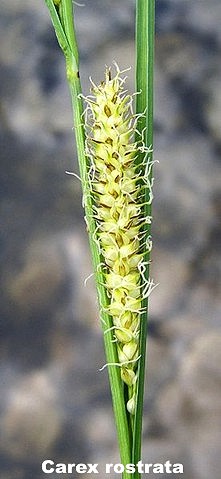
Forse
questa pianta accompagna il Gallus palustris
a pagina 341![]() di Aldrovandi
di Aldrovandi
Famiglia
unica di piante dell'ordine Ciperali che annovera oltre 3000 specie diffuse in
tutto il globo e in particolare nelle zone temperate e fredde. Si tratta di
erbe perenni simili a Graminacee ma con caule pieno e non articolato in nodi,
spesso trigono, con foglie allungate e a nervature parallel. Hanno fiori
rudimentali, sovente aclamidi, muniti di una brattea, unisessuali o
ermafroditi, con tre stami e ovario uniloculare, uniovulato, che dà un
achenio come frutto. In Italia vivono una trentina di specie suddivise in 11
generi, fra i quali i principali sono: Carex![]() ,
Cyperus
,
Cyperus![]() , Scirpus,
Trichophorum. Varie erbe palustri appartenenti ai generi Carex, Cyperus
e Sparganium, usate per lavori di intreccio, vanno sotto il nome di
falasco.
, Scirpus,
Trichophorum. Varie erbe palustri appartenenti ai generi Carex, Cyperus
e Sparganium, usate per lavori di intreccio, vanno sotto il nome di
falasco.
Cyperaceae
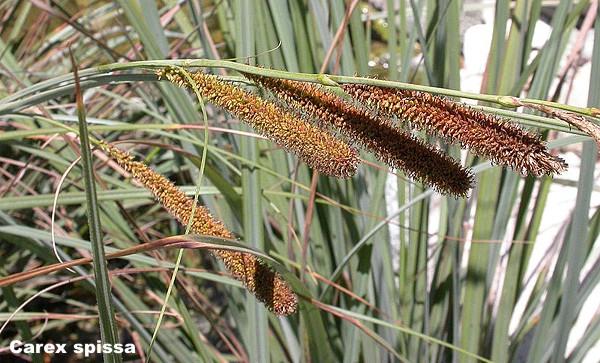
Le Ciperacee (Cyperaceae) sono una famiglia di piante Monocotiledoni appartenente all'ordine delle Poales. Sono piante acquatiche o adattate a vivere su substrati umidi, perciò si rinvengono facilmente negli stagni e nei terreni acquitrinosi. Sono spesso piante infestanti dei tappeti erbosi abbondantemente irrigati e si possono distinguere facilmente per il colore più chiaro, il portamento più compatto e le foglie coriacee. La specie più conosciuta è il papiro (Cyperus papyrus). Il genere Carex è particolarmente ricco di specie, molto simili tra loro, comunemente chiamate carici, piuttosto comuni negli stagni e nelle zone paludose.
Le ciperacee sono piante graminoidi erbacee annuali o perenni, con portamento cespitoso e fusti spesso a sezione triangolare. Le foglie sono alterne, lineari o lineari lanceolate, inserite sul fusto per mezzo di una guaina avvolgente. La lamina è in genere coriacea. I fiori sono unisessuali o ermafroditi, in genere riuniti in spighe. Il perigonio è assente e sostituito da brattee erbacee, dette glume. Apparentemente simili a quelli delle Graminacee, in realtà i fiori delle Ciperacee sono unisessuali oppure sembrano derivati dalla fusione di un fiore femminile con più fiori maschili. Il numero di stami varia da 1 a 6, l'ovario è uniloculare e monovulare, sormontato da uno stilo che si divide in 2-3 stimmi. Il frutto è un achenio indeiscente di consistenza coriacea.
La famiglia comprende circa 70 generi e 4000 specie, ed è suddivisa in 3 sottofamiglie:
Caricoideae
Rhinchosporoideae
Scirpoideae
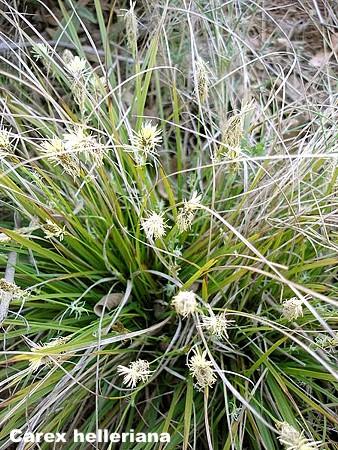
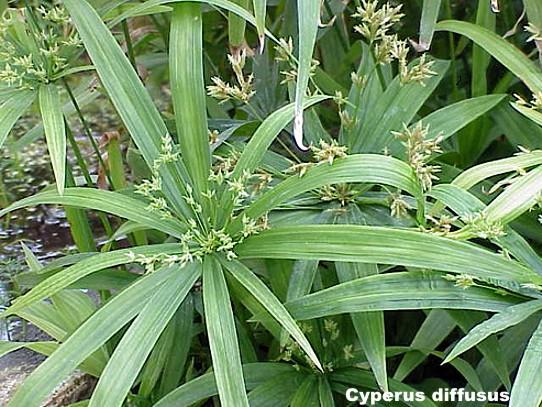
The family Cyperaceae, or the sedges, is a taxon of monocot flowering plants that superficially resemble grasses or rushes. The family is large, with some 4,000 species described in about 70 genera. These species are widely distributed, with the centers of diversity for the group occurring in tropical Asia and tropical South America. While sedges may be found growing in all kinds of situations, many are associated with wetlands, or with poor soils.
Some well-known sedges include the water chestnut (Eleocharis dulcis) and the papyrus sedge (Cyperus papyrus), from which the Ancient Egyptian writing material was made. This family also includes cotton-grass (Eriophorum), spike-rush (Eleocharis), sawgrass (Cladium), nutsedge or nutgrass (Cyperus rotundus, a common lawn weed), the large genus of Carex, and white star sedge (Rhynchospora colorata). Features distinguishing members of the sedge family from grasses or rushes is that members of the sedge family have triangular stems (with occasional exceptions), and their leaves are spirally arranged in three ranks (grasses have alternate leaves forming two ranks).
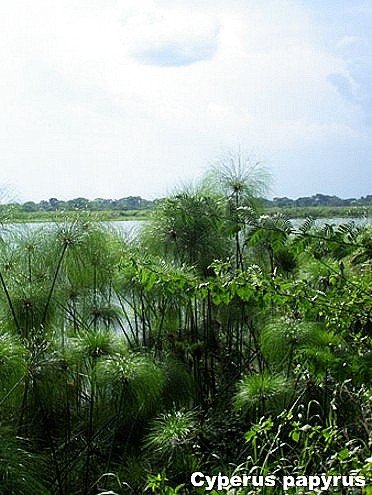
Il papiro egiziano (Cyperus papyrus L.) è una pianta palustre, perenne, rizomatosa, appartenente alla famiglia delle Cyperaceae. Specie erbacea perenne, con fusti alti 2-5 metri e rizoma legnoso molto grosso. Il fusto è trigono, privo di foglie, con diametro di 2-3 centimetri, liscio, di colore verde scuro. All'apice di ogni fusto compaiono brattee lanceolate, arcuate, disposte a ombrello. Le infiorescenze sono ombrelliformi con raggi lunghi da 10 a 30 centimetri, si formano all'estremità superiore dei fusti e portano delle spighe di colore paglierino che contengono acheni allungati. La fioritura avviene da luglio a settembre.
È una specie amante della luce che cresce lungo le rive dei corsi d'acqua a corrente lenta, con le radici sommerse. Può essere riprodotto per talea dal rizoma e dal fusto. È originario dell'Africa tropicale. In Italia il cresce spontaneamente in alcune zone umide della Sicilia, in particolare nella zona di Siracusa, lungo il corso del fiume Ciane e alle sorgenti del Fiumefreddo nel catanese.
Nell'antico Egitto aveva molteplici usi tecnici, il midollo era usato come alimento, fonte di fibre tessili, il rizoma come fonte di combustibile. Celebre la carta particolare, che si otteneva incollando opportunamente strisce di midollo, sulla quale è stata scritta la storia dell'antichità (l'introduzione della pergamena è avvenuta solo nel corso dell'impero romano). Il nome più antico di questa pianta è il greco býblos, derivante da Býblos - Biblo - antica città della Fenicia (situata nei pressi dell'odierno centro di Jbeil o Giubail sulla costa libanese) che ne faceva commercio, da cui i termini libro detto biblíov in greco e Bibbia.

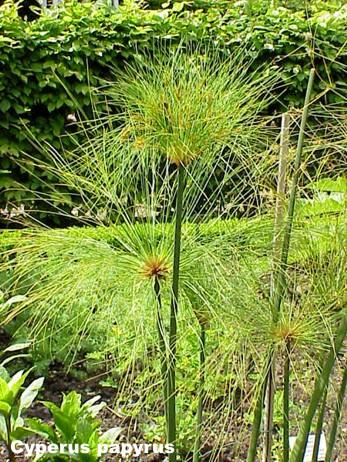
Cyperus papyrus (papyrus sedge or paper reed) is a monocot belonging to the sedge family Cyperaceae. It is a herbaceous perennial native to Africa, and forms tall stands of reed-like swamp vegetation in shallow water. Papyrus sedge (and its close relatives) has a very long history of use by humans, notably by the Ancient Egyptians – it is the source of papyrus paper, parts of it can be eaten, and the highly buoyant stems can be made into boats. It is now often cultivated as an ornamental plant.
This tall, robust, leafless aquatic plant can grow 4 to 5 m (13 to 16 ft) high. It forms a grass-like clump of triangular green stems that rise up from thick, woody rhizomes. Each stem is topped by a dense cluster of thin, bright green, thread-like stems around 10 to 30 cm (4 to 10 in) in length, resembling a feather duster when the plant is young. Greenish-brown flower clusters eventually appear at the ends of the rays, giving way to brown, nut-like fruits. The younger parts of the rhizome are covered by red-brown, papery, triangular scales, which also cover the base of the culms. Botanically these represent reduced leaves, so strictly it is not quite correct to call this plant fully "leafless".
Egyptians used the plant for many purposes, most famously for making papyrus paper. Its name in Greek and in English is widely believed to have come from Egyptian, but this is probably a folk etymology. Cyperus papyrus is now used mainly for decoration, as it is nearly extinct in its native habitat in the Nile Delta, where in ancient times it was widely cultivated. Theophrastus' "History of Plants" (Book iv. 10) states that it grew in Syria; and, according to Pliny's Natural History, it was also a native plant of the Niger River and the Euphrates.
Aside from papyrus, several other members of the genus Cyperus may actually have been involved in the multiple uses Egyptians found for the plant. Its flowering heads were linked to make garlands for the gods in gratitude. The pith of young shoots was eaten both cooked and raw. Its woody root made bowls and other utensils and was burned for fuel. From the stems were made reed boats (seen in bas-reliefs of the Fourth Dynasty showing men cutting papyrus to build a boat; similar boats are still made in the southern Sudan), sails, mats, cloth, cordage, and sandals. Theophrastus states that King Antigonus made the rigging of his fleet of papyrus, an old practice illustrated by the ship's cable, wherewith the doors were fastened when Odysseus slew the suitors in his hall (Odyssey xxi. 390). The "rush" or "reed" basket in which the Biblical figure Moses was abandoned may have been made from papyrus. The adventurer Thor Heyerdahl built two boats from papyrus, Ra and Ra II, in an attempt to demonstrate that ancient African or Mediterranean people could have reached America. He succeeded in sailing Ra II from Morocco to Barbados.
Papyrus ranges from subtropical to tropical desert to wet forests, tolerating annual temperatures of 20 °C (68 °F) to 30 °C (86 °F) and a pH of 6.0 to 8.5. Papyrus flowers in late summer, and prefers full sun to partly-shady conditions. Like most tropical plants, it is sensitive to frost. In the United States it has become invasive in Florida and has escaped from cultivation in Louisiana, California and Hawaii. Papyrus sedge forms vast stands in swamps, shallow lakes, and along stream banks throughout the wetter parts of Africa, but it has become rare in the Nile Delta. In deeper waters it is the chief constituent of the floating, tangled masses of vegetation known as sudd. It also occurs in Madagascar, and some Mediterranean regions such as Sicily and the Levant.
The "feather-duster" flowering heads make ideal nesting sites for many social species of birds. As in most sedges, pollination is effected by wind, not insects, and the mature fruits after release are distributed by water. In recent years papyrus has been the subject of intense ecological studies centered around its prodigious growth rate and ability to recycle nutrients. Much of this research was begun at Makerere University in Uganda in the early 70’s in the swamps on the edge of Lake Victoria and continued in Kenya (University of Nairobi) on Lake Naivasha. John Gaudet’s work in Africa, supported by a National Geographic Society grant, appeared in various scientific journals over the period 1975-1991. In addition, other pioneer researchers of papyrus at Makerere in the 70’s were: Keith Thompson, T. R. Milburn, and Mike Jones. Thompson’s studies of papyrus swamp development throughout Africa (1976-1985) later formed the basis for management and conservation at national levels.
Extensive research on the productive physiology of papyrus were carried out by Jones from the 80's onward. He started his work in Uganda and later continued his research on Lake Naivasha in Kenya where he was joined by a new generation of African researchers including, Frank Muthuri. Jones's latest research (2002) found that papyrus is a C4 sedge which forms highly productive monotypic stands over large areas of wetland in Africa. Jones and others measured eddy covariance from a stand of Cyperus papyrus, which formed a fringing swamp on the north-west shore of Lake Naivasha, Kenya. They determined that fluxes of CO2 and H2O vapor between the papyrus swamp and the atmosphere were large but variable, depending on the hydrology of the wetland system and the condition of the vegetation. These measurements, combined with simulation modeling of annual fluxes of CO2, showed that papyrus swamps have the potential to sequester large amounts of the carbon (1.6 kg C m-2 y-1) when detritus accumulates under water in anaerobic conditions, but they are a net source of carbon release to the atmosphere (1.0 kg C m-2 y-1) when water levels fall to expose detritus and rhizomes to aerobic conditions. Evapotranspiration from papyrus swamps (E) was frequently lower than evaporation from open water surfaces (E o) and plant factors have a strong influence on the flux of water to the atmosphere.
Research on the papyrus swamp habitat has in recent years attracted the attention of many more African biologists, such as A. O. Owino, K. M. Mavuti, S. M. Muchiri and S. Njuguna. Increasingly the value of papyrus to other species is being recognized. Papyrus swamps provide hypoxic and structural refugia for cichlids from the large predatory Nile Perch and are an important habitat for several endangered bird species (Chapman et al. 1996; 2003; Maclean et al. 2003a; 2006). The late 1990s also saw the rise in research on the papyrus swamps of Lake Naivasha in Kenya by teams from the English Universities of Leicester and East Anglia, notably led by David Harper. Harper's extensive recent studies on the swamps and lakes have led to a world-wide awareness of the problems facing papyrus swamps in Africa today.
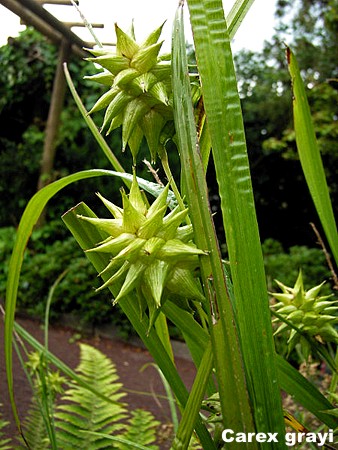
Carex è un genere di piante della famiglia delle Ciperacee. È il genere più ricco di specie dell'intera famiglia. Il genere fu creato da Linneo nel suo volume Species Plantarum nel 1753. Le stime sul numero di specie presenti nel genere variano da circa 1100 fino a 2000. Si trovano in tutto il mondo ma principalmente nelle zone temperate. La maggioranza dei carici (ma non tutti) si trovano in zone umide dove possono costituire la vegetazione dominante, in particolare nelle torbiere basse dette cariceti.
Carex
Carex is a genus of plants in the family Cyperaceae, commonly known as sedges (although other, related species are also called sedges, those of genus Carex may be called "true" sedges). It is the most species-rich genus in the family Cyperaceae. The study of Carex is known as caricology. The term "caricology" derives from Latin: "caricologia." The eminent botanist Carl Ludwig Willdenow published the 107-page book "Caricologia, sive descriptiones omnium specierum caricis, in usum excursionum botanicarum pro amicis seorsim impressa..." in 1805. Also, David Heinrich Hoppe published the 104-page book "Caricologia germanica oder Aufzahlung der in Deutschland wildwachsenden Riedgraser" in 1826.
The genus was established by Carolus Linnaeus in his work Species Plantarum in 1753. Estimates of the number of species vary from about 1100 to almost 2000. Their distribution is global, usually traceable through paleophytogeography, such as strong phylogenetic relationships between many Gondwanaland species. Most (but not all) sedges are found in marshes, where they can be the dominant vegetation. Carix muricata is a rare species which occurs in only a handful of locations within England, and consequently is a protected species under the UK Biodiversity Action Plan.